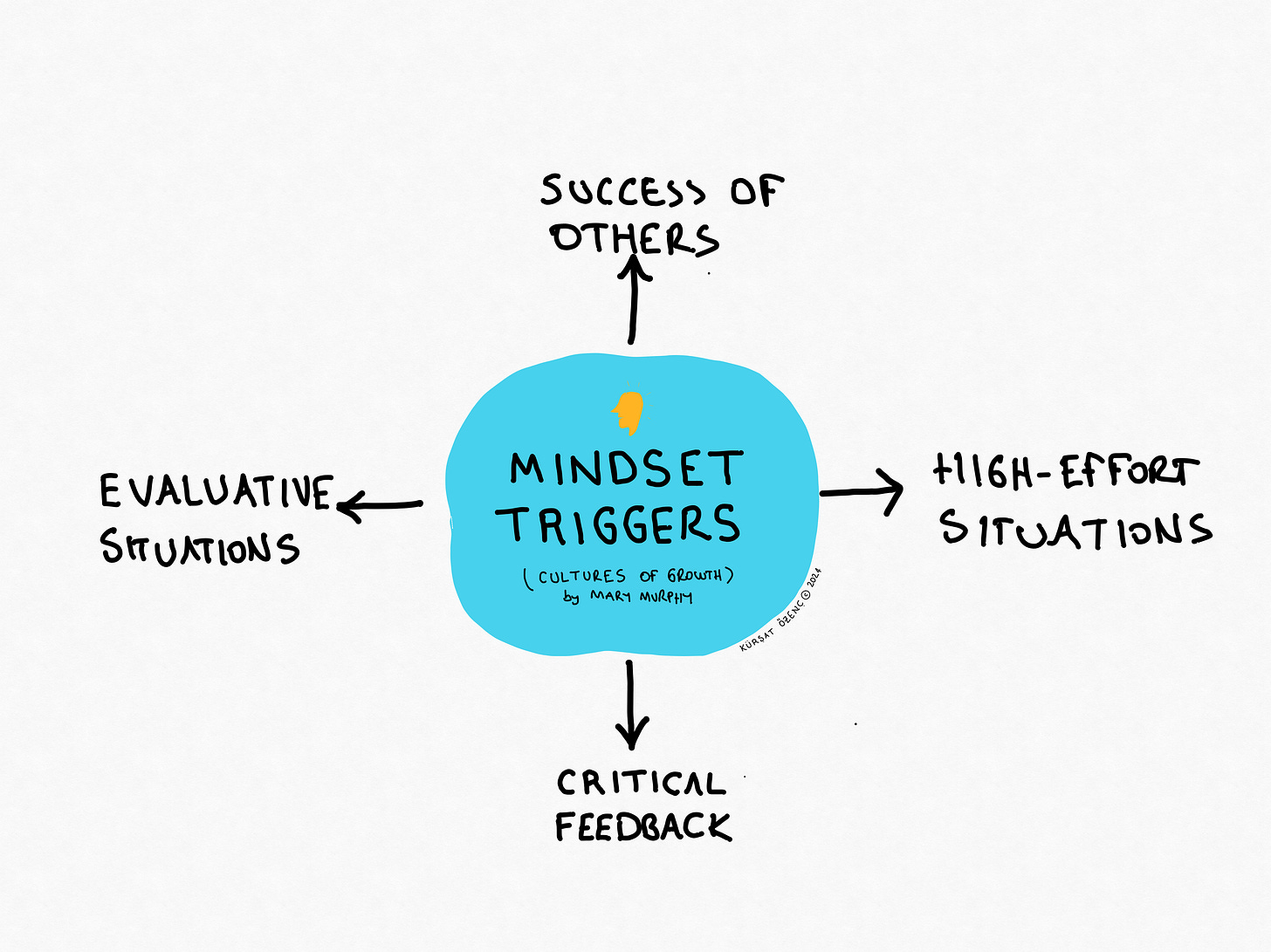Mindsets in the Room and Strategies to Shift Them For the Better
Insights on Mindsets from Cultures of Growth
Welcome to the Culturescapes by Kursat Ozenc. This newsletter examines culture through the design lens. It discusses big ideas and small practices for crafting better cultures in our personal, work, and social spheres.
The key idea in this issue is that mindset is not confined to our brains but is a product of our environment, which opens up a new realm of possibilities. This shift in perspective offers us a fresh understanding of mindset cultures and the potential to reshape them by altering environmental conditions.
I recently read Mary Murphy's book Cultures of Growth and found it refreshing to hear her perspective on mindsets' dynamic nature. Mary Murphy is a professor at Indiana University and one of Carol Dweck's proteges (she was her PhD student at Stanford University.) Carol Dweck is well-known for coining the terms growth versus fixed mindsets. Mary's work builds on her work and introduces the organizational mindset and environments that create them.
What's an organizational mindset?
It refers to shared beliefs about intelligence, talent, and ability. These mindsets shape behaviors, interactions, and expectations, affecting everything from hiring and promotion practices to collaboration and ethical behavior.
The book helped me learn and validate the following insights:
In my writings and teaching, I've been articulating organizational culture as a living system of visible and invisible forces. Mindset is one of those invisible forces of culture. And this is why it's harder to change. To make mindset shifts possible, we need to play with the levers of visible forces, such as policies, cultural practices, norms, and language. Murphy uses real-world examples to illustrate how growth mindset cultures can transform organizations. For instance, Satya Nadella's leadership at Microsoft and the McBride sisters' disruption of the wine industry are highlighted as cases where working on a growth mindset led to significant breakthroughs and success.
Murphy's work also demystifies the fixedness of growth versus fixed mindsets, emphasizing adaptability. She highlights that fixed or growth mindsets are not rigid but exist on a continuum. This adaptability means individuals and organizations can transition between fixed and growth mindsets depending on their context, challenges, and opportunities. For instance, a person or a group might exhibit a growth mindset in one area, such as learning new skills, while displaying a fixed mindset in another, like dealing with failure. This fluidity underscores that mindset is not a fixed state but a spectrum, allowing for movement based on environmental cues and practices.
The dynamic nature of mindsets is a massive opportunity for leaders. This means you can deliberately shift mindsets with intentional interventions. Mary Murphy gives many examples from industry and academia on how mindsets are consequential in shaping organizational cultures. Then, she offers recommendations on how to shift cultures from fixed to growth mindsets. She emphasizes the need for self-awareness and deliberate effort to change these cultures, as seen in the case of Barre3 CEO Sadie Lincoln, who had to overhaul her company's culture after realizing she had unintentionally created a toxic atmosphere of perfectionism. This empowerment and proactive approach are crucial for a growth mindset. A people-centric design approach could catalyze such proactivity since it provides intentionality, tools for designing levers of change (i.e., policy, practice, behaviors), and a robust process from understanding to execution.
Finally, there are several patterns in mindset shifts; the author calls them Mindset Triggers. These are inflictive situations where a person or group could move on the fixed-growth continuum. The triggers are "evaluative," "high effort," "critical feedback," and "success in others" situations. Evaluative and critical feedback, for instance, could be part of an annual performance review where you feel the pressure of being evaluated. In the case of critical feedback, you could find yourself off guard. You can easily fall into a fixed mindset and feel disempowered. She suggests reframing these moments from saving your face to learning moments.
High-effort situations involve being out of your comfort zone and facing challenges you have yet to encounter. For instance, at Google, people are assigned to new teams regularly, and they need to figure out a new challenging situation from the get-go. People in these situations might misperceive that their efforts are not helping them grow in their abilities. The author suggests a reframing where ability increases with effort, meaning that your struggle and hard work will eventually increase your ability. Of course, this is easier said than done. She further gives tactics for not slipping back to a fixed mindset in these moments, including self-affirmation ( I can figure things out), leaning back to your community (social support), and re-programming your fixed mindset beliefs.
The success of others is a powerful trigger that we usually don’t relate to mindset. The idea is that when one of your peers gets a promotion or is acknowledged by the leadership, you go to your fixed mindset corner with feelings of envy, scarcity, and even threat. The author suggests acknowledging such feelings, finding ways to reconnect with the person positively, and then shifting towards a growth mindset by taking their success as an inspiration. In the age of social media, this trigger is constant and flows through people's social media feeds. This could be a good mindset trigger to work on, as we don’t usually associate it with practicing our growth mindset.
This was not an exhaustive book summary, so I highly recommend reading Cultures of Growth. You will find many good examples and tips for your personal and work life.
And this is a wrap for this issue. Until next time, take care of yourself and your loved ones!







